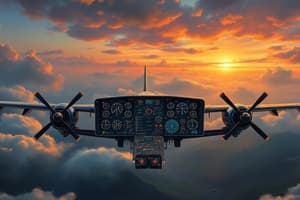Podcast
Questions and Answers
What is the primary benefit of using Integrated Modular Avionics in an aircraft?
What is the primary benefit of using Integrated Modular Avionics in an aircraft?
- Reducing the aircraft's fuel efficiency
- Decreasing maintenance costs and increasing reliability (correct)
- Increasing the number of processor units
- Increasing the workload of flight crew and maintenance personnel
How much weight has been shaved off the avionics suite of the 787 Dreamliner due to the IMA approach?
How much weight has been shaved off the avionics suite of the 787 Dreamliner due to the IMA approach?
- 4000 pounds
- 2000 pounds (correct)
- 1000 pounds
- 3000 pounds
What is a benefit of using fewer computers in the IMA concept?
What is a benefit of using fewer computers in the IMA concept?
- Increasing the number of processor units
- Giving economies in fuel savings and increasing the payload factor derived from less weight (correct)
- Reducing the aircraft's fuel efficiency
- Increasing the workload of flight crew and maintenance personnel
What is enabled by the IMA concept?
What is enabled by the IMA concept?
What is the effect of the IMA concept on the part numbers of processor units for the new A380 avionics suite?
What is the effect of the IMA concept on the part numbers of processor units for the new A380 avionics suite?
What is the primary function of the Backplane Interface Controller (BIC)?
What is the primary function of the Backplane Interface Controller (BIC)?
What is the purpose of the dual-port RAM in the Bus Interface Controller (BIC) frame buffer?
What is the purpose of the dual-port RAM in the Bus Interface Controller (BIC) frame buffer?
What type of data is programmed into the Aircraft Personality Modules (APMs)?
What type of data is programmed into the Aircraft Personality Modules (APMs)?
What is the purpose of the software firewalls in the MAUs?
What is the purpose of the software firewalls in the MAUs?
What is the role of the ASCB coupler in the MAU?
What is the role of the ASCB coupler in the MAU?
What is the function of the Local Area Network (LAN) Controller in the MAU?
What is the function of the Local Area Network (LAN) Controller in the MAU?
What is the primary function of the Avionics Standard-Communication Bus (ASCB)?
What is the primary function of the Avionics Standard-Communication Bus (ASCB)?
What is the speed of the Avionics Standard-Communication Bus (ASCB)?
What is the speed of the Avionics Standard-Communication Bus (ASCB)?
What is the purpose of the resistor terminations in the ASCB?
What is the purpose of the resistor terminations in the ASCB?
What is the duration of each data frame transmitted on the ASCB?
What is the duration of each data frame transmitted on the ASCB?
What is the purpose of the master network interface controller in the ASCB?
What is the purpose of the master network interface controller in the ASCB?
What is the purpose of the transformer coupler in the bus coupler?
What is the purpose of the transformer coupler in the bus coupler?
What is the purpose of the Linear Variable Differential Transformers (LVDTs)?
What is the purpose of the Linear Variable Differential Transformers (LVDTs)?
What is the function of the Primary Actuator Control Electronics (P-ACE) System?
What is the function of the Primary Actuator Control Electronics (P-ACE) System?
What is the purpose of the Autopilot Interface and Orientation Modules (AIOP)?
What is the purpose of the Autopilot Interface and Orientation Modules (AIOP)?
What is the function of the Flight Control Modules (FCMs)?
What is the function of the Flight Control Modules (FCMs)?
What is the purpose of the CAN bus interface?
What is the purpose of the CAN bus interface?
What is the requirement for the autopilot servos to be active and engaged?
What is the requirement for the autopilot servos to be active and engaged?
What is a key difference between the Embraer 170/190's Modular Avionics Unit (MAU) and the A380's avionics system?
What is a key difference between the Embraer 170/190's Modular Avionics Unit (MAU) and the A380's avionics system?
What is the purpose of the Core Processing Input/Output Modules (CPIOMs) on the A380?
What is the purpose of the Core Processing Input/Output Modules (CPIOMs) on the A380?
What is a key feature of the Integrate Modular Avionics (IMA) system on the A380?
What is a key feature of the Integrate Modular Avionics (IMA) system on the A380?
What is the purpose of the Input/Output Modules (IOMs) on the A380?
What is the purpose of the Input/Output Modules (IOMs) on the A380?
What is a characteristic of the Modular Avionics Unit (MAU) on the Embraer 170/190?
What is a characteristic of the Modular Avionics Unit (MAU) on the Embraer 170/190?
How do the LRMs on the A380 differ from those on the Embraer 170/190?
How do the LRMs on the A380 differ from those on the Embraer 170/190?
Flashcards are hidden until you start studying
Study Notes
Integrated Modular Avionics (IMA) Concept
- IMA is a distributed real-time computer network aboard an aircraft, consisting of computing modules supporting various applications with differing safety criticality levels.
- IMA concept reduces maintenance costs and increases reliability by using fewer computers, resulting in fuel savings and increased payload factor.
- Advantages include:
- Reduced workload for flight crew and maintenance personnel
- Multiple functions achieved with a single Line Replaceable Unit (LRU)
Avionics Standard-Communication Bus (ASCB)
- Primary communications path between major subsystems of avionics systems
- High-speed serial data bus (10 Mb/s) using a single shielded twisted pair of wires with resistor terminations to prevent signal reflections
- Data transmitted in 12.5 millisecond frames, divided into blocks or time slots
- Four data buses: Left primary, Right primary, Left backup, and Right backup for redundancy
ASCB Coupler and NIC
- Bus coupler isolates onside primary, onside backup, and cross-side primary buses
- Uses a transformer coupler for isolation and impedance-matching
- NIC (Network Interface Controller) transmits and receives ASCB and LAN data, making it available to other modules in the MAU through the Backplane Interface Controller (BIC)
MAU Boards and Client Modules
- Client modules connected to the backplane bus through an internal circuit called the BIC (Bus Interface Controller) frame buffer
- Dual-port RAM (Random Access Memory) allows read and write access by both the NIC and client module
- Client modules may be a processor, Input/Output (I/O), memory, or other hybrid modules
Aircraft Personality Modules (APMs)
- Installed in the backshells of NIC modules
- Contain custom programming for the aircraft, including system identification, options, system settings, and rigging data
- Protected by software firewalls to prevent malicious data
Data Communications and MAU Operations
- MAUs use ASCB, ASCB coupler, LAN, and CAN data buses for data processing and operations
- Propulsion/APU: Engine and APU fire detection and extinguishing control and indication, thrust reverser control and indication
Comparison of Avionics Systems
- Boeing B777 and B787 avionics systems compared
- EMB 170/190 and A380 Integrated Modular Avionics differences:
- EMB 170/190: Each IMA is a metal cabinet with different LRMs for avionics applications
- A380: Independent LRMs host different avionics applications, some merging 3-4 aircraft systems
A380 IMA System
- Independent applications hosted in Core Processing Input/Output Modules (CPIOMs) and Input/Output Modules (IOMs)
- AIOP modules collect data from avionic and flight control systems via ASCB or other FGCS inputs
- Autopilot servo operation uses bidirectional CAN bus
- Feedback provided by Linear Variable Differential Transformers (LVDTs) and Primary Actuator Control Electronics (P-ACE) System
Studying That Suits You
Use AI to generate personalized quizzes and flashcards to suit your learning preferences.




